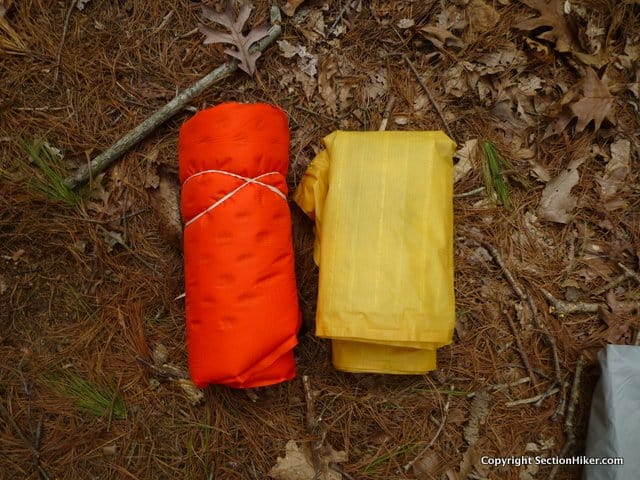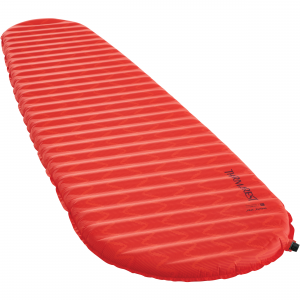The Therm-a-Rest Prolite is a self-inflating sleeping pad with an R-value of 2.4, good for use down to 20-30 degrees Fahrenheit. While self-inflating sleeping pads are not nearly as popular as they were 20 years ago, they are more durable and resilient than inflatable sleeping pads, and much less expensive.
Specs at a Glance
- Weight: 14 oz (size regular)
- R-Value: 2.4
- Dimensions: 72″ x 20″ x 1.0″
If you’ve never used a self-inflating pad like the Therm-a-Rest Prolite, it’s basically an inflatable pad with an open-cell foam pad inside. Open-cell foam compresses because it has air channels running through it. It also has a “memory”, so it will expand after it’s been rolled up. This is different from the closed-cell foam that many sleeping pads are made with, like the Therm-a-rest Zlite or the Ridegrest which can’t be compressed to make them smaller.
The open-cell foam in the Prolite is covered on both sides with a face fabric and sealed around the perimeter of the foam. A valve is then added to the side of the pad, which lets air escape from the interior when the pad is rolled up. When the pad is unrolled, the open cell foam expands, pulling air through the valve and inflating itself. If you want to make the pad firmer, you can top it off with a few breaths (really, just a few) or let some air out to make the mattress softer. If you hate blowing up your inflatable sleeping pad, a self-inflating pad might be a good alternative.

When fully inflated, the Prolite is 1″ thick, compared to a Therm-a-rest NeoAir Xlite which is 2.5″ thick or a Therm-a-rest ZLite, which is 0.75″ thick. Now, some people find the padding provided by a Prolite to be sufficient and others don’t. I can sleep well on a Prolite without any issues, but I’m usually so exhausted from backpacking all day, that sleeping well is not a problem. I’m a side sleeper, a back sleeper, and a thrasher, and there’s still sufficient padding for me to stay comfortable.
One of the things that I like about the Prolite is that it’s available in a wide variety of lengths and gear weights. For instance, sleeping on a shorter pad is a common trick used by ultralight backpackers to reduce gear weight, since your legs need less insulation than your torso for 3 season camping. To insulate your legs, you can simply prop them on top of your backpack and spare clothing and that is sufficient to keep them warm.
- Small: (12 oz) – 47″ x 20″
- Regular (18 oz) – 72″ x 20″
- Large : (24 oz) – 77″ x 25″
This means you can enjoy the improved comfort that a Prolite provides compared to a foam sleeping pad with little weight penalty. For instance, a 47″ long Prolite weighs 12 oz, while a 72″ long Therm-a-Rest Zlite foam pad weighs 14 oz, a weight savings of 2 oz.

A 47″ Prolite also stacks up well against a 47″ Therm-a-Rest NeoAir XLite or a 48″ NEMO Tensor, which only weigh 2 and 3 oz less, but are far less durable. If you’ve ever poked a hole or sliced open the face fabric on an inflatable sleeping pad, they’re useless in terms of sleep insulation. But if you hole a Prolite, the inner foam will still provide you with enough insulation to get through the night. This improved durability is one reason why hardcore backpackers carry a Therm-a-Rest Prolite instead of an ultralight inflatable sleeping pad. Desert thorns and old nails in lean-to floors can’t penetrate its face fabric, but they’ll pop most inflatable sleeping pads like a cheap balloon.
Therm-a-Rest provided the author with a Prolite sleeping pad for this review.
Compare 3 Prices
-

 Amazon US
Amazon US$134.94$117.41ViewAmazon.com Price: $117.41 (as of 04/19/2024 13:16 GMT-0400) Details
Product prices and availability are accurate as of the date/time indicated and are subject to change. Any price and availability information displayed on Amazon.com at the time of purchase will apply to the purchase of this product.
-

 Therm-a-Rest$134.95View
Therm-a-Rest$134.95View -

 Eastern Mountain Sports$134.95View
Eastern Mountain Sports$134.95View
 SectionHiker.com Backpacking Gear Reviews and FAQs
SectionHiker.com Backpacking Gear Reviews and FAQs 
I used a Women’s Prolite IV for many years and still have it as a loaner. It’s 66″ long, lighter and cheaper than the regular and bridges the size between full length and torso length. They’re high value pads.
And the women’s pads are warmer than men’s too!
Do the women’s pads contain more insulating material? I haven’t found a good explanation for why the R values are so much higher for women’s pads.
Usually, they’re just smaller so they trap your body heat more efficiently.
Love my 3/4 length Prolite!! I have a 3/4 length neo Air and a z lite too. The problem with the neo Air that no one talks about us that it’s too thick for use with a pillow! I love my UL inflatable pillow but can’t use it with the neo Air unless I shim it with a rock or something to boost it higher. Otherwise my head is dangling over the edge of the pad and is completely uncomfortable. Or you put the pillow on the pad but then you have to move your whole body down further which pushes you off the pad.
The prolite is the perfect height and gives enough cushion and warmth for anything I’ve thrown at it.
And it’s way cheaper than the neo Air.
Zlite is ok but bulky and cold.
I use the XLite and a pillow. By putting my shoes under the pillow, it raises it up high enough for comfort. I put the toe area under the edge of the XLite and the rest of the shoe under the pillow. The slope of the shoe up to the foot opening allows for adjustment.
yeah, that’s a good idea. unless the shoes are hella muddy or smelly!
The smell of my trail runners would make a moose gag!
i’m always interested in these pads, because i hate how high inflatables are. Do you feel like it’s worth the weight? I could be tempted to drop my CCF pad and move to this if the weight wasn’t a huge tradeoff…
That’s why I recommend getting a short one (weighs less). I think they’re a lot more comfortable than CCF.
I’ve thought about combing the Prolite small with a portion of Z Lite…more comfy Prolite plus something the sit on at camp,ECT..little extra weight..but not much…lots of durability plus options
Love my women’s prolite. Quieter than other inflatables I’ve tried.
Good point!
My old Prolite rarely gets used these days. When I lived in the southwest the Prolite was the way to go. I still offer it several times a year as a loaner pad without complaint, so it gets the job done.
What did turn me off about the Prolite was when I winter dry-camped when the ground temp was below freezing. I generally go to sleep and stay asleep, but the cold seeping from the ground woke me around 3 am, which of course awoke my bladder. That was the last cold winter trip the Prolite attended.
Xtherm year-round is the current kit. Though for summer, that BA AXL sans insulation looks pretty sweet for the southeastern mountain ground-dwellers. My rain jacket weighs more….
(can’t afford to upgrade everything at once).
They also make the Prolite Plus with a higher R-value, though the 47″ small weighs 4 oz. more.
Once I reached a certain age (which I’m well past), my increasingly pressure-sensitive joints needed a thicker pad! The progression started with no pad as a teenager, then a foam pad, then a Thermarest. At age 55, I went to a thicker Thermarest–ridiculously heavy, and after a few years, it still didn’t provide the padding I needed. I replaced it with a 2.5″ thick insulated air pad, which is still good after 15 years! Obviously, I am very careful with it and go over the ground thoroughly before pitching my tent.
What do you think of the Prolite Plus, if you’ve tried it?
I had one for many years, but my wife gave it to my niece.
It’s heavier and thicker, but has all of the advantages of the regular Prolite.
Check out the women’s Prolite as well. They tend to have a higher R-value.
I used the shorty 1” thick Therm-a-Rest self inflators all through the nineties in the northeast. Mostly fall camping in New England, motorcycle touring and tenting in state campgrounds and some backpacking in the Catskills. Those things worked like a champ, down to freeze point. I never liked air mattresses, no matter how fancy or expensive they got. Too noisy and don’t like the feeling. I move around a lot too I guess. I am much older now , so I thought I’d treat myself to an updated, full length model. Same weight as my old ones, just bigger to pack. Frankly, I wish I had a new shorty, less size and weight! Now I live in Fla and get up to Ga. to backpack. The 1” ones are fine on the ground, but not so comfy on wood floors of shelters. I prefer the self inflating ones.
I’ve gone back to self-inflating pads after a dalliance with air mats. I found I don’t like being so high off the ground – bits of me keep falling off and causing gaps around my quilt, which doesn’t happen so much on the lower pad. And the self-inflating mats are less faff at the end of a long day.
But these days you can look beyond the ProLite. The Nordisk Ven 2.5 short mat is slightly larger and gives the same R at less weight, and the Exped SIM HL gives a higher R at the same weight. But compared to the ProLite they both use a significantly lighter 20D face fabric, so you lose out on durability.
The Ven is so light that I can combine it with a mid-size plastazote closed cell mat for a similar weight to my Exped Synmat UL M. The plastazote gives extra insulation for my trunk and legs and protects the Ven from pointy objects. The plastazote is also multi-use and is great for resting on the trail, hanging out in camp, laying out my gear for packing and so on. And I’m getting a combined R of around 3.5 which extends below freezing.
If you find you can sleep comfortably on the new breed of lightweight self-inflators, they open up some interesting options.
Therm-a-Rest has a new for 2019 ProLite Apex Sleeping Pad. REI has them. R value of 4, thicker and a touch lighter than the Prolite Plus, and has a Regular/Wide option. $30 more than a Prolite, $20 more than the Plus.
Last year I got a Prolite Apex. I was sick of bouncing around on air pads and puncturing them no matter how careful I think I am (though I’m now pretty good at repairs in the field). Ahhh, the Apex is so much more comfortable. Easy to set up. More durable. I also love that I could get it in Regular Wide so now my arms don’t fall off the sides. It isn’t as warm as my Exped downmat but everything else is better.